MAPbI3 Microrods-Based Photo Resistor Switches: Fabrication and Electrical Characterization
Abstract
1. Introduction
2. Materials and Methods
2.1. Preparation of Microrods
2.2. Device Preparation
2.3. Characterization
3. Results and Discussion
4. Conclusions
Supplementary Materials
Author Contributions
Funding
Institutional Review Board Statement
Informed Consent Statement
Data Availability Statement
Acknowledgments
Conflicts of Interest
References
- Li, J.; Li, H.; Ding, D.; Li, Z.; Chen, F.; Wang, Y.; Liu, S.; Yao, H.; Liu, L.; Shi, Y. High-performance photoresistors based on perovskite thin film with a high PbI2 DOPING LEVEL. Nanomaterials 2019, 9, 505. [Google Scholar] [CrossRef]
- Targhi, F.F.; Jalili, Y.S.; Kanjouri, F. MAPbI3 and FAPbI3 perovskites as solar cells: Case study on structural, electrical and optical properties. Results Phys. 2018, 10, 616–627. [Google Scholar] [CrossRef]
- Zhang, Y.; Liu, J.; Wang, Z.; Xue, Y.; Ou, Q.; Polavarapu, L.; Zheng, J.; Qi, X.; Bao, Q. Synthesis, properties, and optical applications of low-dimensional perovskites. Chem. Commun. 2016, 52, 13637–13655. [Google Scholar] [CrossRef] [PubMed]
- Zhang, H.; Liu, M.; Yang, W.; Judin, L.; Hukka, T.I.; Priimagi, A.; Deng, Z.; Vivo, P. Thionation Enhances the Performance of Polymeric Dopant-Free Hole-Transporting Materials for Perovskite Solar Cells. Adv. Mater. Interfaces 2019, 6, 1901036. [Google Scholar] [CrossRef]
- Liu, M.; Zhang, H.; Gedamu, D.; Fourmont, P.; Rekola, H.; Hiltunen, A.; Cloutier, S.G.; Nechache, R.; Priimagi, A.; Vivo, P. Halide Perovskite Nanocrystals for Next-Generation Optoelectronics. Small 2019, 15, 1900801. [Google Scholar] [CrossRef] [PubMed]
- Deng, W.Z.X.; Huang, L.; Xu, X.; Wang, L.; Wang, J.; Shang, Q.; Lee, S.T.; Jie, J. Aligned single-crystalline perovskite microwire arrays for highperformance flexible image sensors with long-term stability. Adv. Mater. 2016, 28, 2201–2208. [Google Scholar] [CrossRef] [PubMed]
- Zhu, C.; Tang, Y.; Chen, F.; Manohari, A.G.; Zhu, Y.; Shi, Z.; Xu, C. Fabrication of self-assembly polycrystalline perovskite microwires and photodetectors. J. Cryst. Growth 2016, 454, 121–127. [Google Scholar] [CrossRef]
- Im, J.-H.; Luo, J.; Franckevičius, M.; Pellet, N.; Gao, P.; Moehl, T.; Zakeeruddin, S.M.; Nazeeruddin, M.K.; Grätzel, M.; Park, N.-G. Nanowire perovskite solar cell. Nano Lett. 2015, 15, 2120–2126. [Google Scholar] [CrossRef] [PubMed]
- Mishra, A.; Ahmad, Z.; Touati, F.; Shakoor, R.; Nazeeruddin, M.K. One-dimensional facile growth of MAPbI3 perovskite micro-rods. RSC Adv. 2019, 9, 11589–11594. [Google Scholar] [CrossRef]
- Wang, H.P.; Li, S.; Liu, X.; Shi, Z.; Fang, X.; He, J.H. Low-Dimensional Metal Halide Perovskite Photodetectors. Adv. Mater. 2021, 33, 2003309. [Google Scholar] [CrossRef] [PubMed]
- Lin, C.-H.; Li, T.-Y.; Zhang, J.; Chiao, Z.-Y.; Wei, P.-C.; Fu, H.-C.; Hu, L.; Yu, M.-J.; Ahmed, G.H.; Guan, X. Designed growth and patterning of perovskite nanowires for lasing and wide color gamut phosphors with long-term stability. Nano Energy 2020, 73, 104801. [Google Scholar] [CrossRef]
- Raza, E.; Ahmad, Z.; Mishra, A.; Aziz, F. Metal halide-based photodetector using one-dimensional MAPbI3 micro rods. J. Mater. Sci. Mater. Electron. 2020, 31, 12109–12115. [Google Scholar] [CrossRef]
- Kim, D.J.; Tak, Y.J.; Kim, W.G.; Kim, J.K.; Kim, J.H.; Kim, H.J. Resistive switching properties through iodine migrations of a hybrid perovskite insulating layer. Adv. Mater. Interfaces 2017, 4, 1601035. [Google Scholar] [CrossRef]
- Rossel, C.; Meijer, G.; Bremaud, D.; Widmer, D. Electrical current distribution across a metal–insulator–metal structure during bistable switching. J. Appl. Phys. 2001, 90, 2892–2898. [Google Scholar] [CrossRef][Green Version]
- Khoon, T.N.; Sebastian, P.; Saman, A.B.S. Autonomous fire fighting mobile platform. Procedia Eng. 2012, 41, 1145–1153. [Google Scholar] [CrossRef]
- McGrath, M.J.; Scanaill, C.N. Sensing and sensor fundamentals. In Sensor Technologies; Springer: Berlin/Heidelberg, Germany, 2013; pp. 15–50. [Google Scholar]
- Hur, S.-G.; Kim, E.-T.; Lee, J.-H.; Kim, G.-H.; Yoon, S.-G. Enhancement of photosensitivity in CdS thin films incorporated by hydrogen. Electrochem. Solid State Lett. 2008, 11, H176. [Google Scholar] [CrossRef]
- Zhang, K.; Hu, C.; Tian, Y.; Zheng, C.; Wan, B. Stable and highly photosensitive device of CdSe nanorods. Phys. E Low-Dimens. Syst. Nanostruct. 2011, 43, 943–947. [Google Scholar] [CrossRef]
- Pentia, E.; Pintilie, L.; Matei, I.; Botila, T.; Pintilie, I. Combined chemical–physical methods for enhancing IR photoconductive properties of PbS thin films. Infrared Phys. Technol. 2003, 44, 207–211. [Google Scholar] [CrossRef]
- Simma, M.; Lugovyy, D.; Fromherz, T.; Raab, A.; Springholz, G.; Bauer, G. Deformation potentials and photo-response of strained PbSe quantum wells and quantum dots. Phys. E Low-Dimens. Syst. Nanostruct. 2006, 32, 123–126. [Google Scholar] [CrossRef]
- Liu, F.; Hu, Z.; Sun, J.; Li, Z.; Huang, H.; Zhao, J.; Zhang, X.; Wang, Y. Ultraviolet photoresistors based on ZnO thin films grown by P-MBE. Solid-State Electron. 2012, 68, 90–92. [Google Scholar] [CrossRef]
- Baikie, T.; Fang, Y.; Kadro, J.M.; Schreyer, M.; Wei, F.; Mhaisalkar, S.G.; Graetzel, M.; White, T.J. Synthesis and crystal chemistry of the hybrid perovskite (CH3NH3)PbI3 for solid-state sensitised solar cell applications. J. Mater. Chem. A 2013, 1, 5628–5641. [Google Scholar] [CrossRef]
- Vincent, B.R.; Robertson, K.N.; Cameron, T.S.; Knop, O. Alkylammonium lead halides. Part 1. Isolated PbI64− ions in (CH3NH3)4PbI6•2H2O. Can. J. Chem. 1987, 65, 1042–1046. [Google Scholar] [CrossRef]
- Ning, S.; Zhang, S.; Sun, J.; Li, C.; Zheng, J.; Khalifa, Y.M.; Zhou, S.; Cao, J.; Wu, Y. Ambient Pressure X-ray Photoelectron Spectroscopy Investigation of Thermally Stable Halide Perovskite Solar Cells via Post-Treatment. ACS Appl. Mater. Interfaces 2020, 12, 43705–43713. [Google Scholar] [CrossRef]
- McGettrick, J.D.; Hooper, K.; Pockett, A.; Baker, J.; Troughton, J.; Carnie, M.; Watson, T. Sources of Pb(0) artefacts during XPS analysis of lead halide perovskites. Mater. Lett. 2019, 251, 98–101. [Google Scholar] [CrossRef]
- Singh, J.; Singh, R.; Gautam, S.K.; Gupta, H.; Singh, F. A versatile multifaceted resistive switching memory activated by light and ion irradiation in poly (3-octylthiophene)-zinc oxide hybrids. Org. Electron. 2020, 87, 105932. [Google Scholar] [CrossRef]
- Stojanovic, B. Magnetic, Ferroelectric, and Multiferroic Metal Oxides; Elsevier: Amsterdam, The Netherlands, 2018. [Google Scholar]
- Chiu, F.-C. A review on conduction mechanisms in dielectric films. Adv. Mater. Sci. Eng. 2014, 2014. [Google Scholar] [CrossRef]
- Deng, H.; Dong, D.; Qiao, K.; Bu, L.; Li, B.; Yang, D.; Wang, H.-E.; Cheng, Y.; Zhao, Z.; Tang, J. Growth, patterning and alignment of organolead iodide perovskite nanowires for optoelectronic devices. Nanoscale 2015, 7, 4163–4170. [Google Scholar] [CrossRef]
- Zafar, Q.; Ahmad, Z. Dual donor bulk-heterojunction to realize a quick and more sensitive organic visible photodector. J. Mater. Sci. Mater. Electron. 2018, 29, 11144–11150. [Google Scholar] [CrossRef]
- He, M.; Chen, Y.; Liu, H.; Wang, J.; Fang, X.; Liang, Z. Chemical decoration of CH3NH3PbI3 perovskites with graphene oxides for photodetector applications. Chem. Commun. 2015, 51, 9659–9661. [Google Scholar] [CrossRef]
- Wang, Y.; Xia, Z.; Du, S.; Yuan, F.; Li, Z.; Li, Z.; Dai, Q.; Wang, H.; Luo, S.; Zhang, S. Solution-processed photodetectors based on organic–inorganic hybrid perovskite and nanocrystalline graphite. Nanotechnology 2016, 27, 175201. [Google Scholar] [CrossRef]
- Zhang, X.; Liu, C.; Ren, G.; Li, S.; Bi, C.; Hao, Q.; Liu, H. High-switching-ratio photodetectors based on perovskite CH3NH3PbI3 nanowires. Nanomaterials 2018, 8, 318. [Google Scholar] [CrossRef]

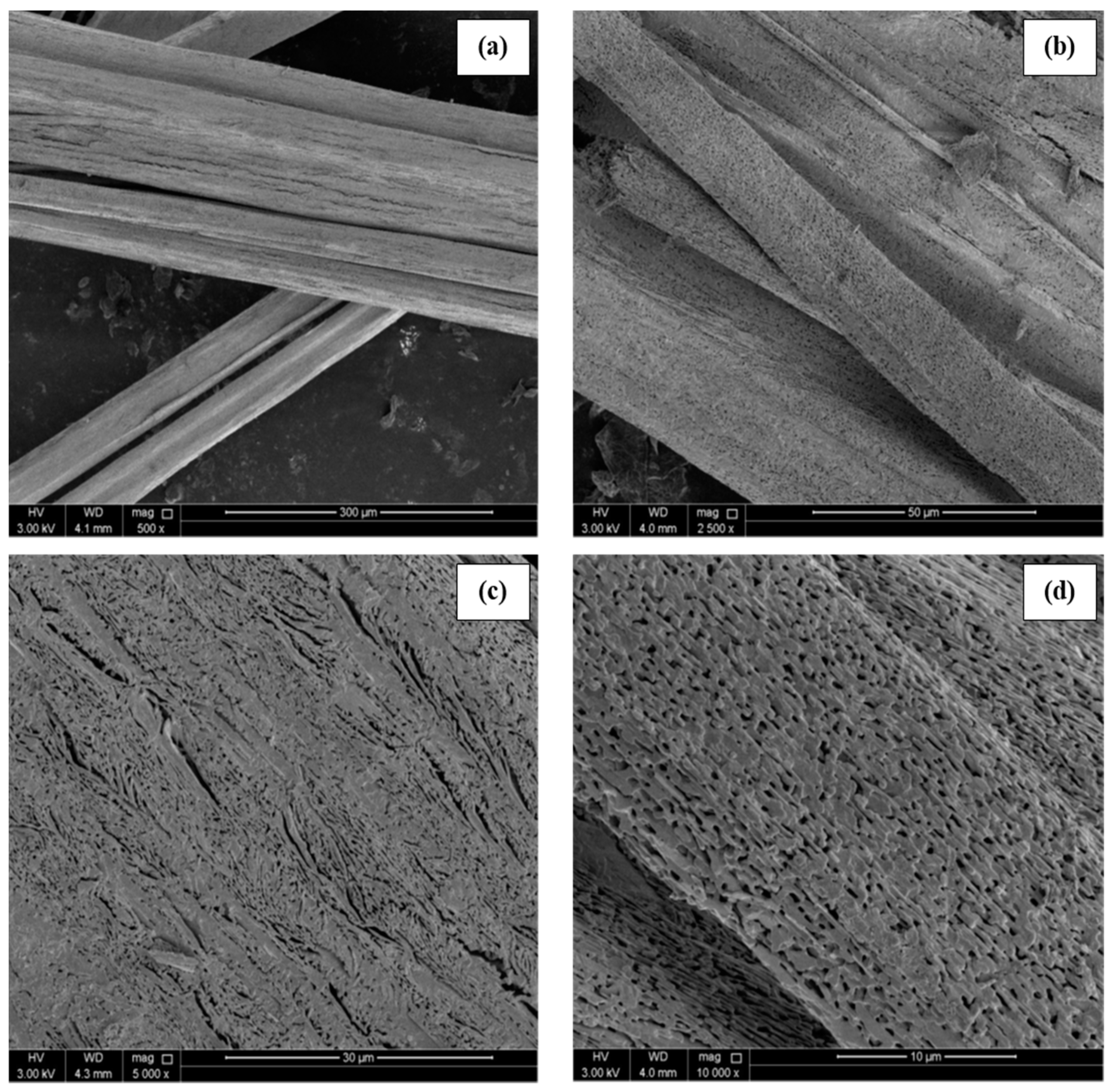

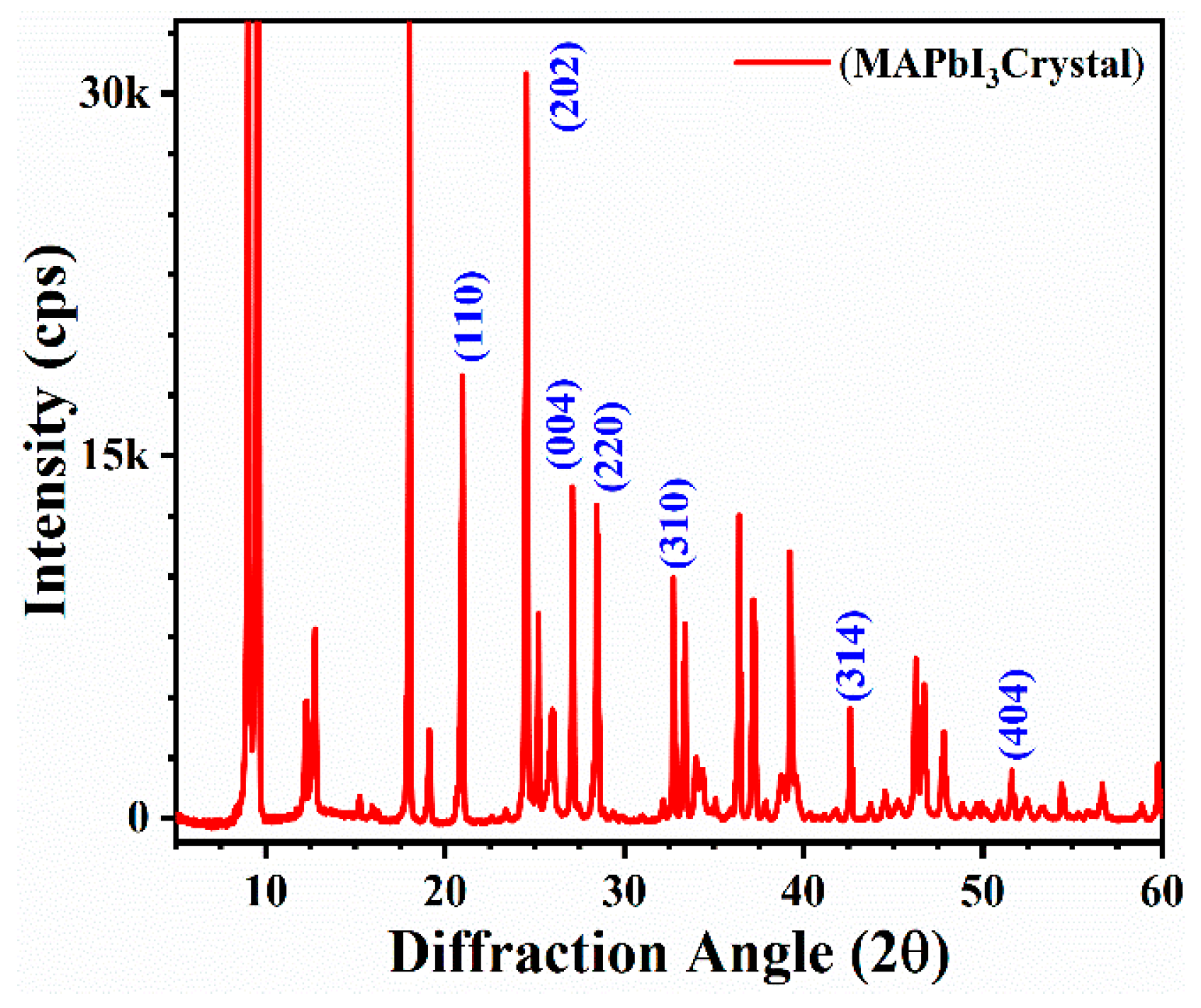
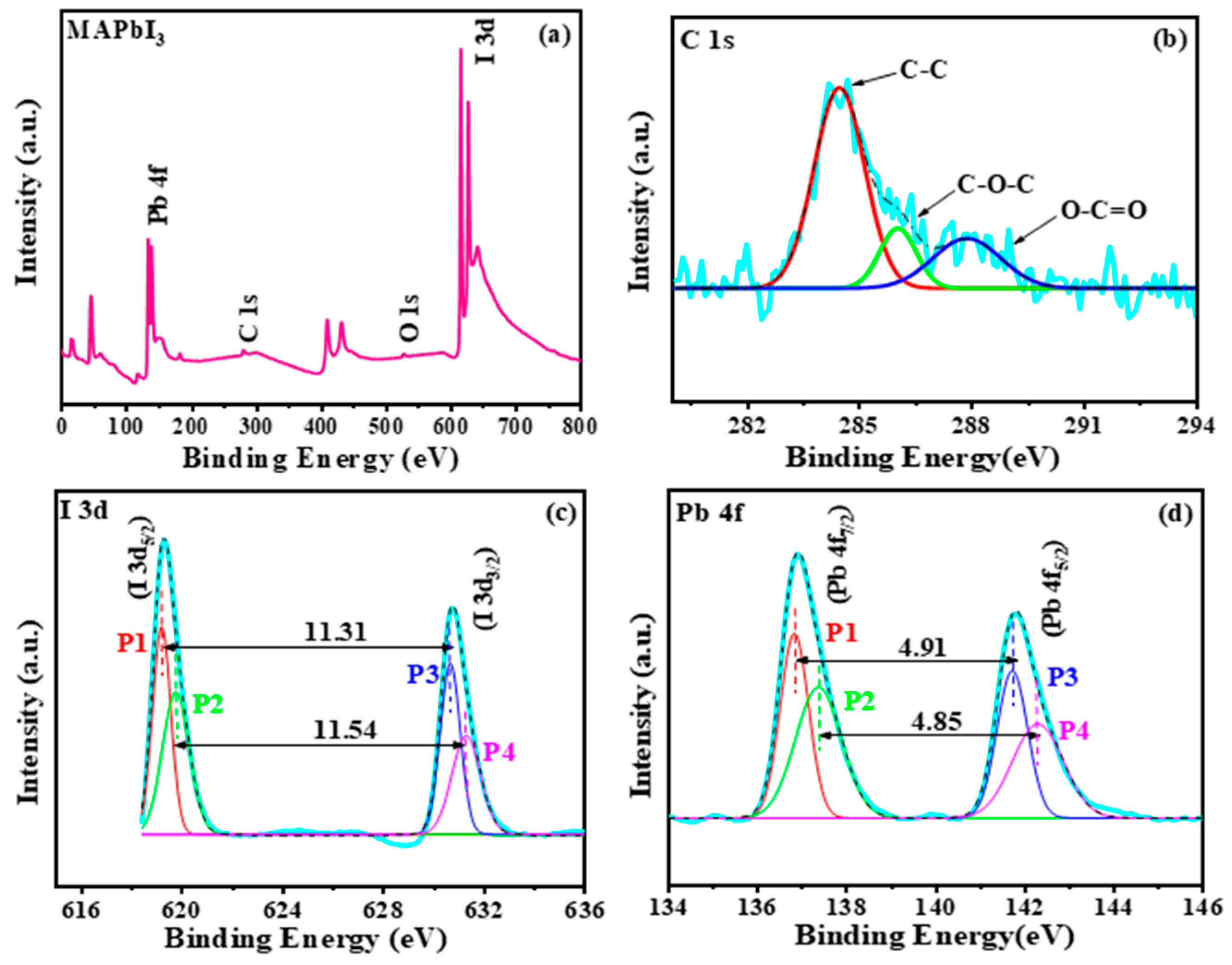

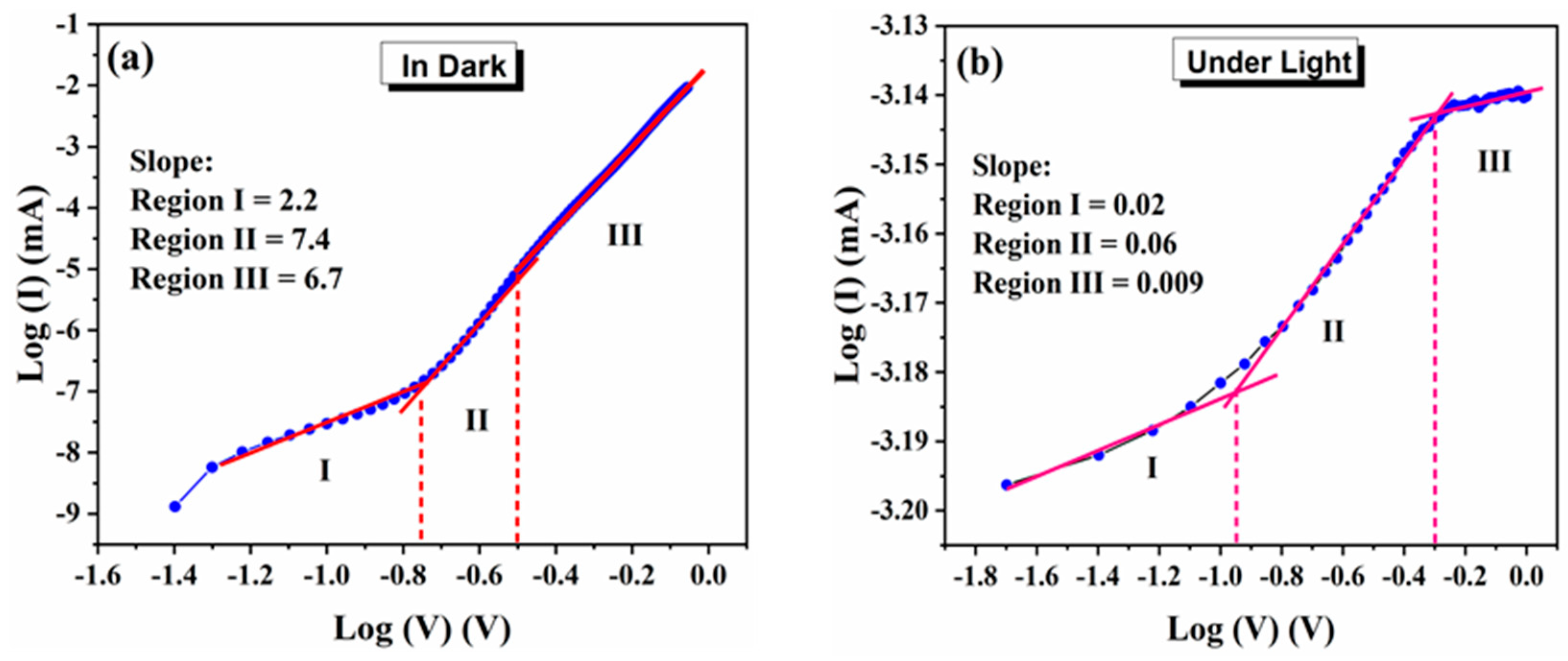
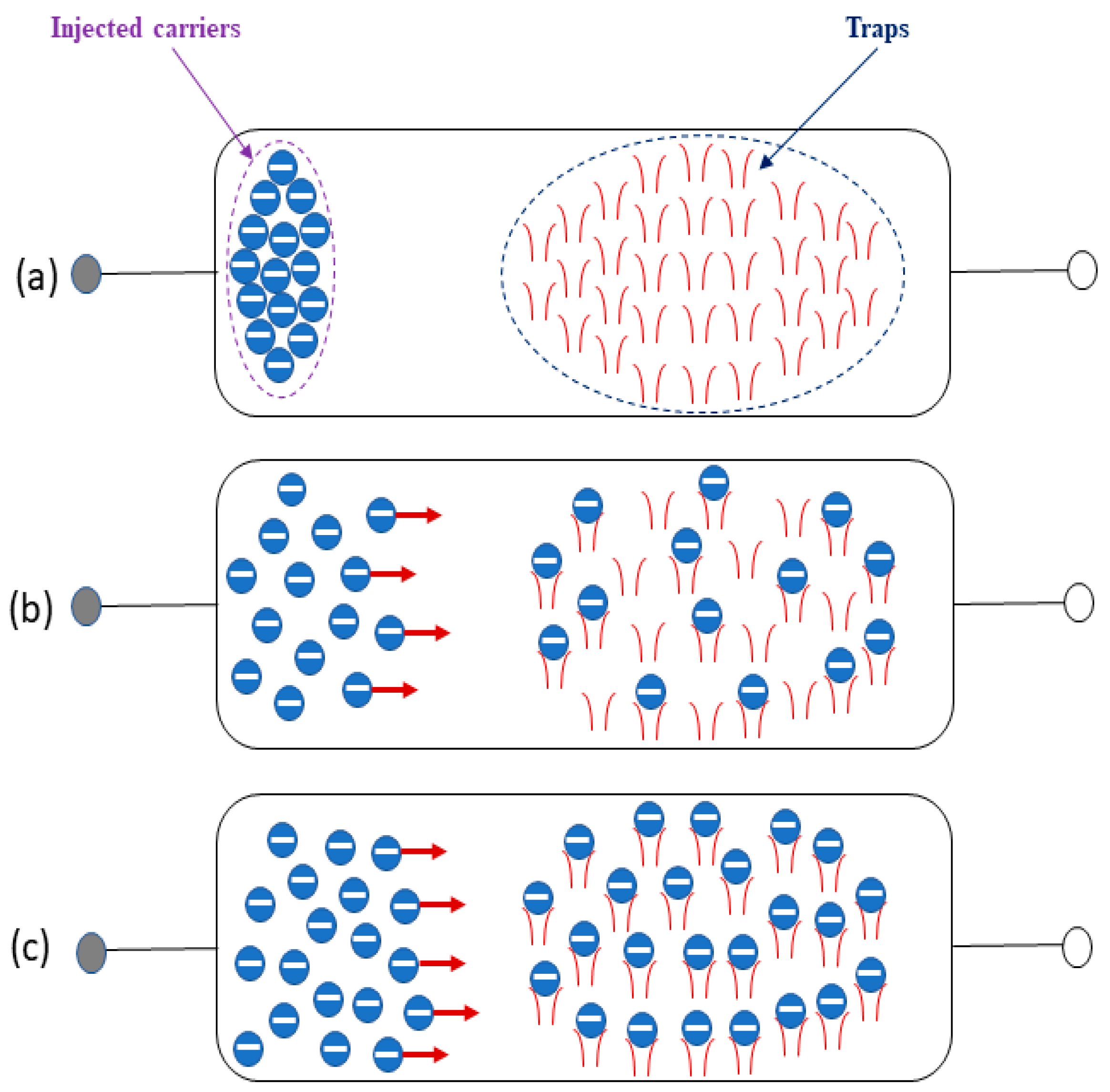
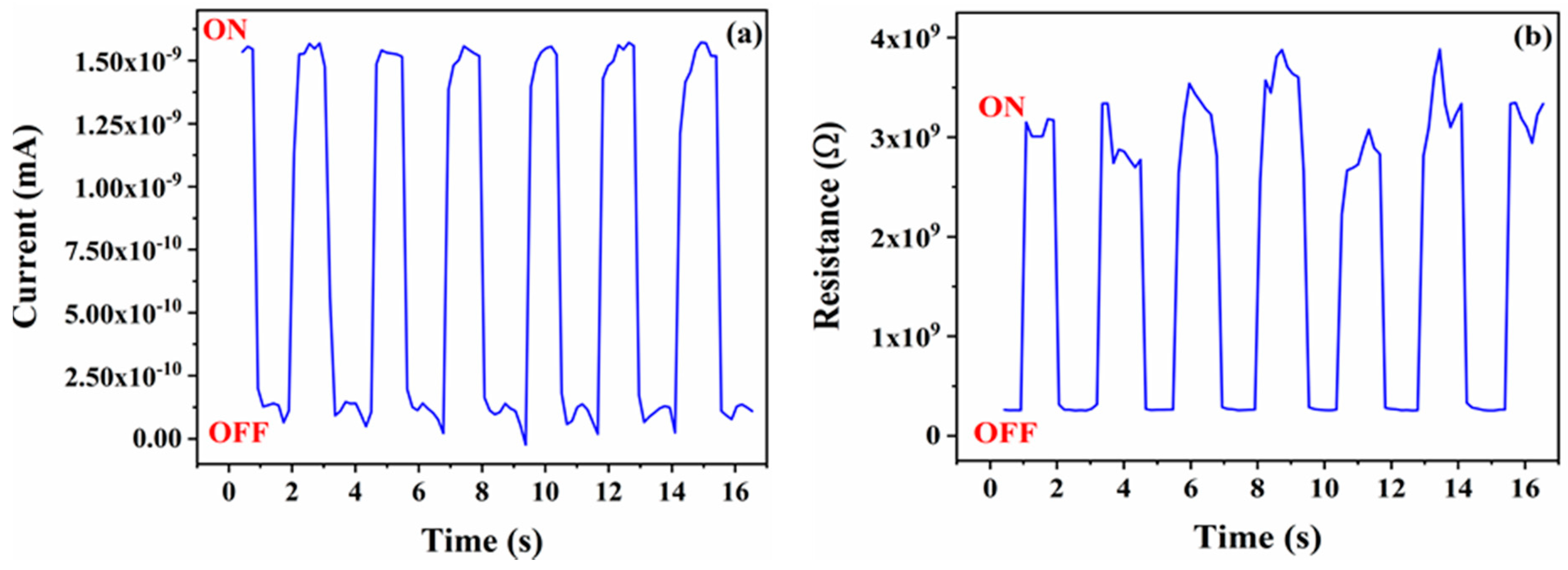
Publisher’s Note: MDPI stays neutral with regard to jurisdictional claims in published maps and institutional affiliations. |
© 2021 by the authors. Licensee MDPI, Basel, Switzerland. This article is an open access article distributed under the terms and conditions of the Creative Commons Attribution (CC BY) license (https://creativecommons.org/licenses/by/4.0/).
Share and Cite
Raza, E.; Aziz, F.; Mishra, A.; Al-Thani, N.J.; Ahmad, Z. MAPbI3 Microrods-Based Photo Resistor Switches: Fabrication and Electrical Characterization. Materials 2021, 14, 4385. https://doi.org/10.3390/ma14164385
Raza E, Aziz F, Mishra A, Al-Thani NJ, Ahmad Z. MAPbI3 Microrods-Based Photo Resistor Switches: Fabrication and Electrical Characterization. Materials. 2021; 14(16):4385. https://doi.org/10.3390/ma14164385
Chicago/Turabian StyleRaza, Ehsan, Fakhra Aziz, Arti Mishra, Noora Jabor Al-Thani, and Zubair Ahmad. 2021. "MAPbI3 Microrods-Based Photo Resistor Switches: Fabrication and Electrical Characterization" Materials 14, no. 16: 4385. https://doi.org/10.3390/ma14164385
APA StyleRaza, E., Aziz, F., Mishra, A., Al-Thani, N. J., & Ahmad, Z. (2021). MAPbI3 Microrods-Based Photo Resistor Switches: Fabrication and Electrical Characterization. Materials, 14(16), 4385. https://doi.org/10.3390/ma14164385






